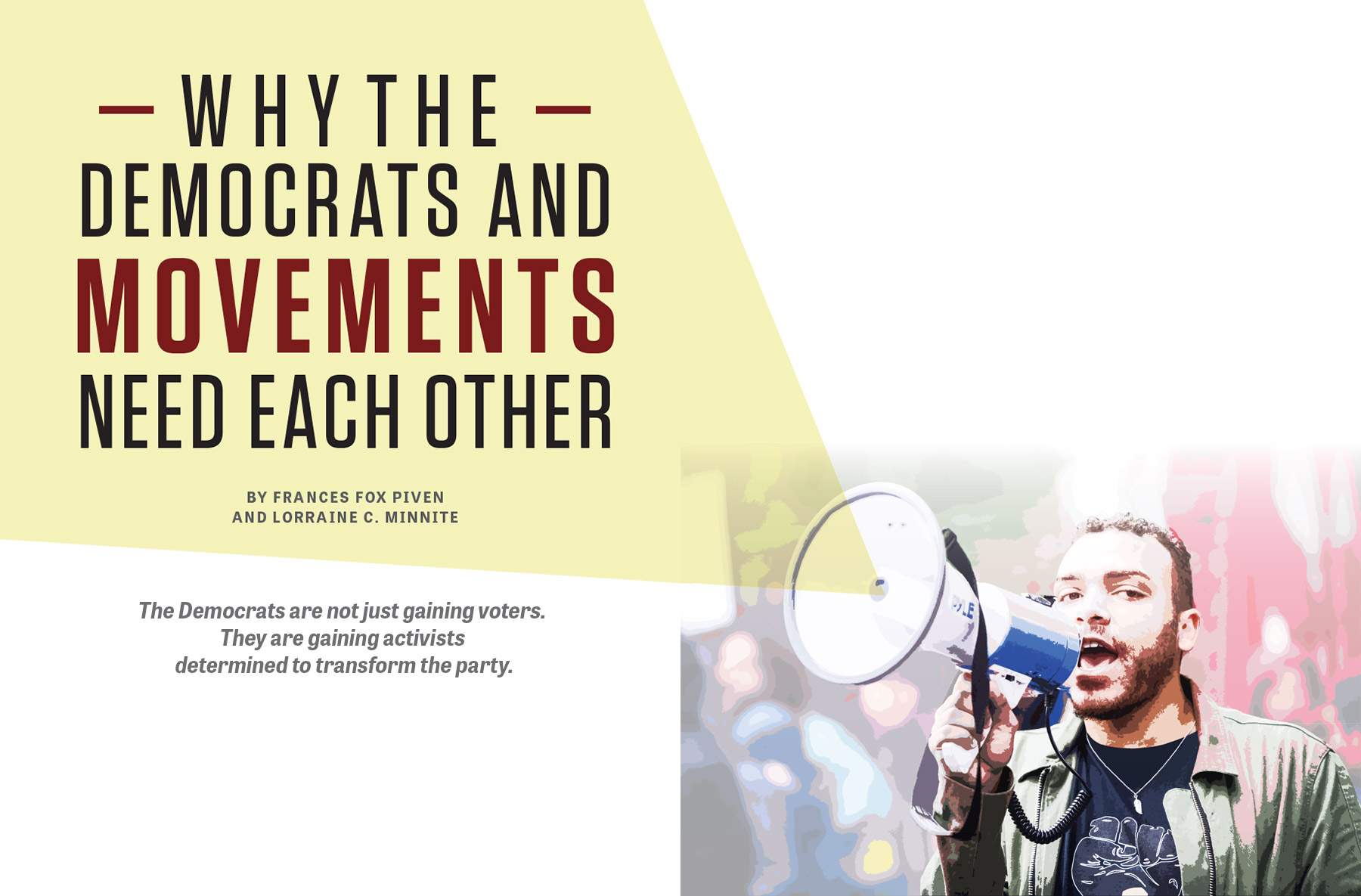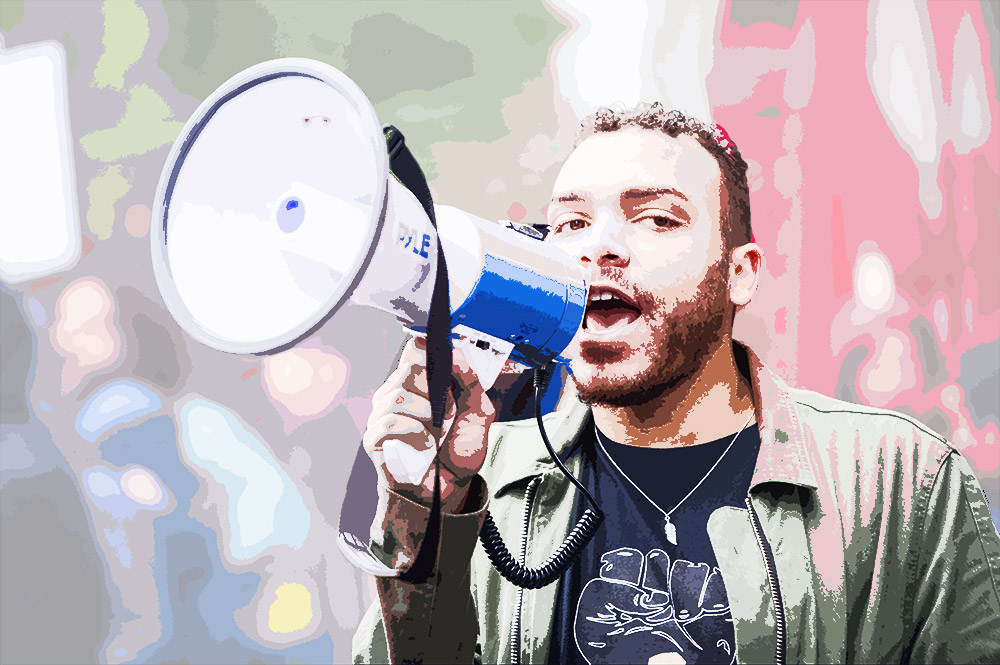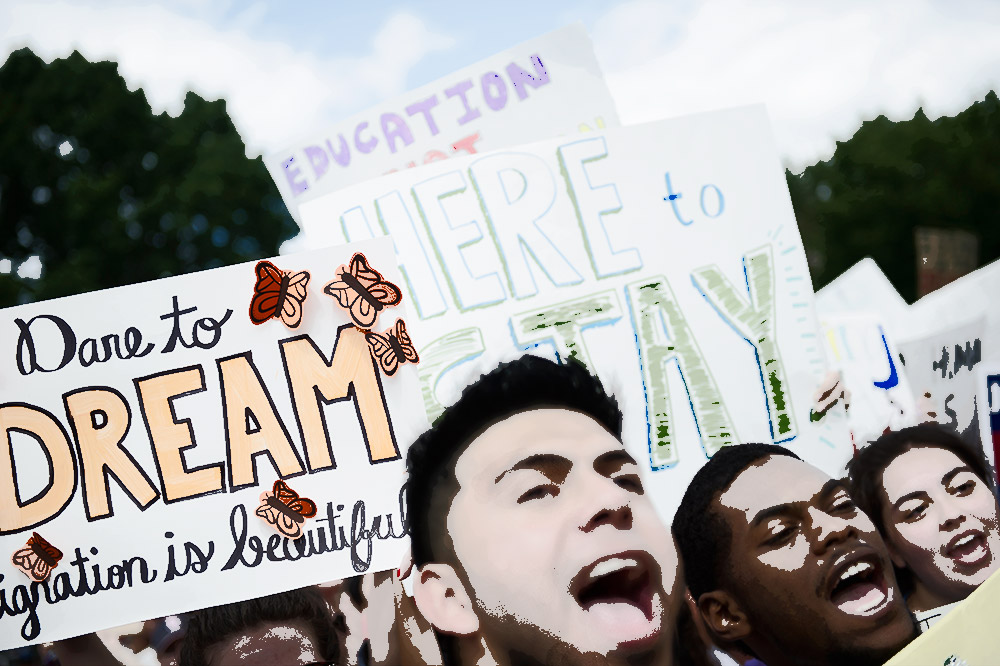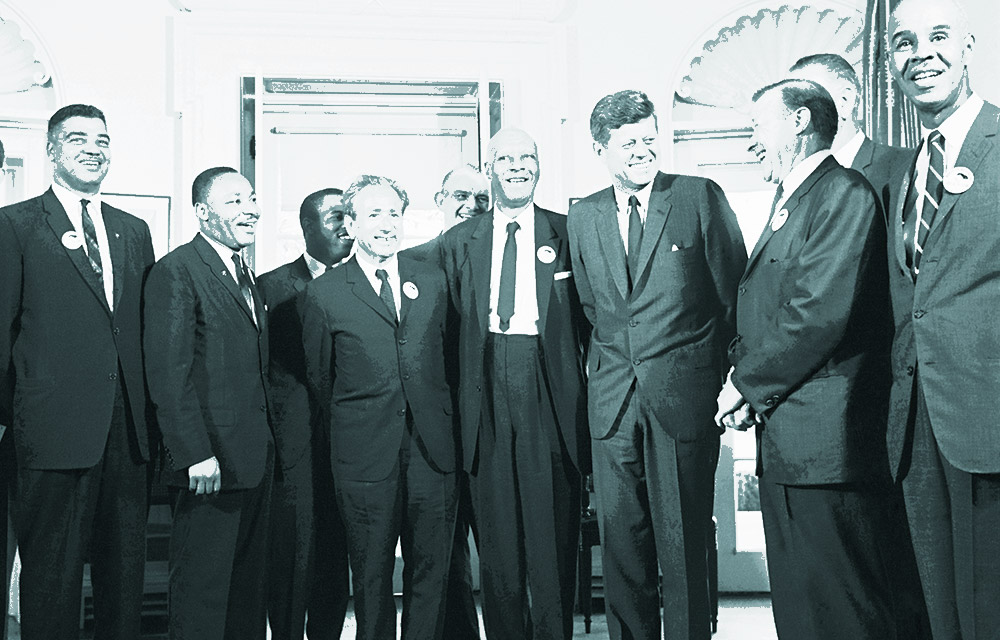

Why Democrats and Movements Need Each Other
The Democrats are not just gaining voters. They are gaining activists determined to transform the party.
Above: Demonstrators in Portland, Ore., protest Attorney General Jeff Sessions' anti-immigrant measures on September 19. (Photo by Diego G Diaz/Icon Sportswire via Getty Images)
October 18, 2017 | November Issue
A striking feature of the current political moment is that many activists on the Left are flocking to the Democratic Party. At first glance, this makes sense simply as a reaction to the narrow and disputed electoral victory of the bizarre and dangerous Donald Trump.
But the Democrats are not merely gaining voters. They are gaining activists, people who are committing not only to pull the party lever in the voting booth, but who are determined to rejuvenate and transform the party, beginning at the local level. This development is encouraging, and not only because it could make a difference in the 2018 midterms and the next presidential election.
Until the shock and fear of a Trump-led government took center stage, some on the Left viewed elections and movement building as separate, even irreconcilable, paths to reform. While their skepticism about the Democratic Party was not misplaced, we argue that movements also depend on electoral politics. The growth, morale and effectiveness of today’s movements will depend on the success of the current surge of enthusiasm for Democratic Party activism.
Why some on the Left are turning to the Democratic Party
Compared to the Obama years and the noisy 2016 election itself, the enthusiasm for Democratic Party activism welling up on the broad Left today is startling. It already overshadows the usual Democratic Party electoral ground game of enlisting labor and other grassroots constituencies to knock on doors, distribute literature and make phone calls to prime voters. Hundreds of groups at the national and local levels have organized to recruit new Democratic candidates and work on campaigns. Long-standing organizations that support Democratic candidates, such as Emily’s List, are seeing unprecedented growth, and movement organizations, from the Democratic Socialists of America to the Movement for Black Lives, are getting involved in local and state races.

Demonstrators gather in front of the White House September 9 to protest President Donald Trump’s intention to rescind the Deferred Action for Childhood Arrivals Act (DACA). (Photo by Rod Lamkey Jr/SOPA Images/LightRocket via Getty Images)
While fear of Trump has galvanized even centrist liberals, much of the new energy and organizing know-how is coming from left-leaning activists. Though surprising, it is not hard to explain the sudden enthusiasm for electoral action. The dangers of Donald Trump in the White House and a right-wing Republican Party in control of Congress, the Supreme Court and more than half of the states are glaring.
The path toward this new electoral activism was paved by the Bernie Sanders campaign, which made credible the prospect of engaging in a fight within the Democratic Party for a more radical and democratic economic program, for racial and social justice, and for peace. As historian Max Elbaum has observed, the polarization of the country grew during the 2016 election. But the sectors of the Left that grew the most were those energized by the Sanders campaign. Our Revolution, an organization inspired by that campaign, now claims some 400 local chapters that are trying to shift the Democratic Party to the left, in part by backing progressive local and state candidates.
THE GROUPS REJUVENATING THE DEMOCRATS
Swing Left coordinates funding and volunteers to help Democrats win Republican-held seats in swing districts. It has targeted 64 House seats for the 2018 mid-terms.
Indivisible, a virtually self-organized national effort, began as a Google Doc after the 2016 election. It has attracted a good many experienced political professionals, and it concentrates on blocking Trump’s federal initiatives.
The Sister District Project works on electing Democrats to state legislatures. It claims some 25,000 volunteers in 50 states.
Run for Something focuses on recruiting and mentoring younger people to run in down-ballot races.
Emily’s List recruits and trains pro-choice female Democratic candidates. The 32-year-old group has seen an explosion of interest since the election, with more than 17,000 women signing up for its “Run to Win” training program. As a result, the organization has tripled its state and local staff operations.
Our Revolution was created by Sen. Bernie Sanders to sustain the momentum of the his 2016 campaign. It claims some 400 local chapters and focuses on taking control of the Democratic Party and on supporting progressive candidates in the vast number of state and local races that normally get little attention.
Brand New Congress, a political action committee established by former staffers and supporters of Bernie Sanders’ campaign, works to elect Democrats to Congress who support Sanders’ policies and platform, even if that means opposing sitting Democrats in party primaries.
The Movement for Black Lives, which began as a protest movement against police violence in 2013, is still in the streets, but it has begun focusing on get-out-the-vote drives and local electoral campaigns, such as the race for Philadelphia district attorney.
Labor for Our Revolution grew out of Labor for Bernie, a coalition of union members who backed Sanders in 2016. They recently launched a campaign with organizations such as Justice Democrats and National Nurses United to pressure Democrats in Congress to sign on to a progressive People’s Platform.
Democratic Socialists of America, founded in 1982, has more than doubled its membership since the election, becoming the nation’s largest socialist organization, with over 120 chapters. The group has developed a plan to help progressives win local elections and to build support for national political change.
Working Families Party, created two decades ago in New York City to push the state Democrats to the left, has since expanded to a dozen other states and created a national membership. It endorses and runs candidates and builds community-labor coalitions to press for progressive policies.
The path to victory will be difficult. In the House, if the Democrats can hold on to the seats they already have, they still need to win an additional 24 seats. In the Senate, the prospects are more daunting: The Democrats must defend three times as many seats as the Republicans, 10 in states won by Trump, half of those by double digits.
It will take time, then, to oust the Republicans from their commanding position at the national level. That is why so much Left energy has been focused on down-ballot elections. Victories on the local level can matter. Not only do they boost the morale of electoral and movement activists alike, but in our federal system, localities often have significant policy authority.
An astonishing number of state and local elected offices go uncontested. One study found that, between 1992 and 2010, a third of all state legislative incumbents did not face a challenger in the primary and general elections. Another study found that, in six states, half of all mayoral candidates ran unopposed.
In Virginia, for example, where all statewide offices are held by Democrats and Clinton defeated Trump by five points, the lower House of Delegates has long been dominated by Republicans. Forty of the Republicans’ 66 seats were uncontested by Democratic challengers in 2015. While it still might be a long shot, with the election of Trump and the new energy for electoral politics on the left, in 2018 the GOP could lose the 17 Republican House of Delegates seats that voted for Clinton in 2016.
Such a victory would be unprecedented, but the challenge is being embraced by a new grassroots political action committee, Activate Virginia, founded by Josh Stanfield, a 30-year-old Sanders delegate to the Democratic National Convention, and two other activists. The group’s mission is to field and support progressive Democratic candidates in all 100 House of Delegates elections. As of this writing, these aggressive efforts have shrunk the number of upcoming uncontested elections against Republican incumbents from 40 (in 2015) to 10.
Virginia’s example, which points to a key weakness of the Democratic Party, also offers an opportunity to strengthen the influence of the Left. The two major political parties are not parties in the sense of disciplined, unified, hierarchical membership organizations. Rather, they are loose and conflict-ridden confederations of separate leadership groups whose overall structure reflects the complex constitutional and institutional arrangements of the U.S. federal system.
The point, however, is not to belabor the weakness of fractious and institutionally hamstrung political parties, but rather to note that the institutional fragmentation of the Democratic Party makes it susceptible to takeover. As an example of how centrists have exploited this political reality, consider the creation of the Democratic Leadership Council (DLC) in 1985. The so-called Third Way was designed to stymie the progressive, pro-labor party activism stimulated by Jesse Jackson’s presidential campaigns in 1984 and 1988, and other efforts to move the party to the Left. And it succeeded—until the recent Sanders challenge loosened the grip that centrists had on the party for the past 30 years.

Sen. Elizabeth Warren (D-Mass.) speaks with Sen. Bernie Sanders (I-Vt.) on Medicare for All in Washington, D.C., on September 13. (Photo by Jim Watson/afp/ Getty Images)
This kind of synergy between electoral and movement politics may be emerging in the area of healthcare. On the one side, Trump and the right-wing majority in Congress have put forward a series of Draconian legislative proposals to dismantle the Affordable Care Act, and especially the provisions that underwrite healthcare for the poor. On the other side, the political furor over these efforts has given a big bump to the Sanders-backed Medicare for All Act, with 16 Democratic senators now signed on. The legislative drama, in turn, is likely to boost the morale and increase the energy of the longer-term movement for a publicly funded healthcare system.
Why Movements Need Electoral Politics
The two major parties also matter because they play a very large role in shaping the life course of movements. This dynamic is often overlooked because the fundamental dynamics of movements and electoral campaigns are different. Movement activists work to raise the issues that divide and anger constituencies, while electoral operatives tend to smooth over the divisions that inhibit the building of the winning majority that elections require. In these respects, movement and electoral dynamics are antagonistic. But that is by no means the whole of it.
Movements also depend on elected leaders who are susceptible to or embrace the challenges that movements generate. They thrive when they get the rhetorical support of the elected leaders who worry about defections from movement-influenced constituencies. Moreover, the policy victories that movements score are ultimately fashioned by elected politicians.
As an example, consider the recent fortunes of the environmental movement. The same year Barack Obama was first elected president, a Canadian firm, TransCanada, had applied for a permit to build a 1,200-mile pipeline across the American Midwest to connect Canadian tar sands oil with Gulf Coast oil refineries. The company and the oil lobby misleadingly claimed that the project would create 140,000 jobs and billions in economic benefits; the Canadian government pressured a newly elected President Obama to approve the project. In April 2010, the U.S. State Department concluded the pipeline would have a limited effect on the environment. Political strategists inside the White House convinced the president to stop using the term “climate change” and to focus on “clean energy jobs” and a “clean energy economy” to avoid drawing fire from the fossil fuel industry and conservatives. Meanwhile, oil lobbyists used propaganda to successfully shift public opinion on climate change. In 2008, acceptance that its causes were human-made was 72 percent. Two years later, only 52 percent agreed.
Environmental activists rejected their insider tactics and began to build a coalition of grassroots groups that went well beyond normal lobbying and interest group politics, bringing together ranchers and land rights advocates in red states like Nebraska, and Native tribes whose land would be violated and water threatened by the project.
At the time, Bill McKibben, a leader of the movement, wrote, “Now we know what we didn’t before. Making nice doesn’t work ... we may need to get arrested.” In late August 2011, protestors mounted a two-week campaign in front of the White House, joined by some of the large environmental groups that are not usually associated with civil disobedience, and more than 1,200 people got arrested. On Nov. 6, 2011, thousands of protesters surrounded the White House in what they called a “solidarity hug” to urge Obama to veto the pipeline. Under intense pressure from the Republican-controlled Congress to move the project forward, in 2015, Obama exercised his veto power for only the third time.
The re-energized environmental movement did its work in the streets. But the crucial point is that friendly Democrats ultimately conceded to the demand. The delays won by a broad and inclusive coalition of opposition groups to the pipeline using direct action, civil disobedience, and mass arrests exerted political pressure on a wobbly president.

President John F. Kennedy stands with prominent civil rights and labor leaders, including Martin Luther King Jr., Whitney Young and Walter Reuther. (Photo by Bettmann / Contributor/ Getty Images)
The great and transformational movements of the past—the radical Democrats of the Revolutionary War era, or the abolitionists of the 19th century, or the 20th century labor movement, or the Black freedom movement, or the women’s movement, or the movements for personal rights included under the LBGTQ acronym—all scored their successes because they activated the elementary and fundamental power of ordinary people. The essence of that power is the refusal to cooperate in the basic institutional arrangements of a society. That is what movement power is: The power of the strike writ large, encompassing not only refusal in the workplace but in civil society itself.
Refusal isn’t easy, and that is an important reason why movements depend on electoral politics. All of the influences of the institutions that mold daily life collaborate to make the exercise of movement power difficult, as do the immediate threats and punishments that the dominant society imposes on movements. Most of the time, electoral politics legitimizes those threats and punishments, giving the authority of tradition and legal procedure to the threat of force that usually suppresses rebellion. But sometimes, when electoral calculations lead politicians to recognize that they need voter support from among emerging movement constituencies, mass discontent is sufficient to lead at least some political leaders to rhetorically side with the discontented. By doing so, they of course give courage and moral support to emerging movements, as Roosevelt’s campaign rhetoric gave courage to an emerging labor movement, or Kennedy’s rhetoric nourished the Black freedom movement, or Obama’s sympathy for Trayvon Martin encouraged the Movement for Black Lives. The importance of this encouragement cannot be overstated.
Electoral context matters for another reason. The disruption that ensues from movement leverage can cleave the electoral base of a governing party, compelling political elites to respond with ameliorating reform. When that happens, it is elected politicians who fashion the policy measures that respond to movement demands and disorder. We need politicians in charge of that process who lean toward the Left and its movements. Even when movement leverage succeeds in forcing action on policy reform, the movement itself is only one of the influences in crafting the policy change. We want the thumbs of legislators like Elizabeth Warren and Bernie Sanders on the scale in legislative deliberations. And that means movements need a rejuvenated Democratic Party. 
An earlier version incorrectly identified Josh Stanfield as a founder of Progressive House VA.
writes about movements and American politics. Her books include Poor People’s Movements and Challenging Authority: How Ordinary People Change America.
teaches at Rutgers University-Camden. She is a national expert on voter suppression in American politics.
Want to stay up to date with the latest news on political movements? Subscribe to the free In These Times weekly newsletter:
